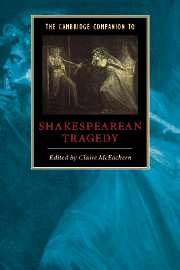Book contents
- Frontmatter
- 1 What is a Shakespearean tragedy?
- 2 The language of tragedy
- 3 Tragedy in Shakespeare’s career
- 4 Shakespearean tragedy printed and performed
- 5 Religion and Shakespearean tragedy
- 6 Tragedy and political authority
- 7 Gender and family
- 8 The tragic subject and its passions
- 9 Tragedies of revenge and ambition
- 10 Shakespeare’s tragedies of love
- 11 Shakespeare’s classical tragedies
- 12 The critical reception of Shakespeare’s tragedies
- 13 Antony and Cleopatra in the theatre
- Select bibliography
- Index
- Series List
13 - Antony and Cleopatra in the theatre
Published online by Cambridge University Press: 28 May 2006
- Frontmatter
- 1 What is a Shakespearean tragedy?
- 2 The language of tragedy
- 3 Tragedy in Shakespeare’s career
- 4 Shakespearean tragedy printed and performed
- 5 Religion and Shakespearean tragedy
- 6 Tragedy and political authority
- 7 Gender and family
- 8 The tragic subject and its passions
- 9 Tragedies of revenge and ambition
- 10 Shakespeare’s tragedies of love
- 11 Shakespeare’s classical tragedies
- 12 The critical reception of Shakespeare’s tragedies
- 13 Antony and Cleopatra in the theatre
- Select bibliography
- Index
- Series List
Summary
Speaking to himself – and heard by an offstage audience – Hamlet decides to have the visiting troupe of actors 'play something like the murder of my father': 'the play's the thing', he concludes, 'Wherein I'll catch the conscience of the king'. Hamlet imagines theatrical enactment as a persuasive intervention which will provoke his uncle to reveal his guilt. Implicitly, he also affirms that his words – and those of the already 'extant' play in the troupe's repertoire – will tell only part of the story and that the acted and felt play will be the 'real' thing. Real, and also material, for performance not only reimagines 'the play' but invites us to think concretely about how words – and silences – do theatrical work. How do particular actors' bodies, their physical and gestural languages, make meanings; how do theatrical set design, lighting, and costume discipline and enhance those bodies? How do particular spaces and stage images arrest attention, remain etched in memory? Tracing a range of performances of a play such as Antony and Cleopatra – once considered by literary critics to be, like King Lear, unperformable – opens a window on to a flexible, shape-shifting theatrical literacy and legacy, revealing how changes in theatrical spaces and fashions, in critical and cultural histories, have shaped and reshaped both the imaginative and material contours of Cleopatra’s ‘infinite variety’ as well as those of the play.
- Type
- Chapter
- Information
- The Cambridge Companion to Shakespearean Tragedy , pp. 241 - 263Publisher: Cambridge University PressPrint publication year: 2003



